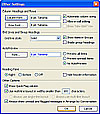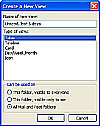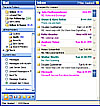- Working with Views
- Creating Custom Views
- Using Folder Home Pages
- Summary
- Q&A
Creating Custom Views
The power of views comes not from the predefined views, but from the ability to create your own custom views. You can customize the current view used on any folder, create new views, or customize any of the default views included with Outlook.
All custom view options are on the Custom View dialog. Open the dialog by right-clicking on the field names at the top of the list pane and selecting Custom.
The options you can choose from when customizing or creating views include
-
Fields—Select the fields you want visible in your view, or remove fields you don't need, using the Show Fields dialog (see Figure 3.6). Use this dialog to control the number of lines used in the multiline layout. Not all of these options are available for all view types.
-
Group By—Enables you to choose specific fields to group by or use the default of Automatically Group According to Arrangement (see Figure 3.7). Automatic grouping enables you to click on a field name and group by that field or select a grouping from the smart grouping menu. The Group By dialog also has the default Expand/Collapse setting for the view.
-
Sort—Enables you to choose up to four fields to sort by, in ascending or descending order. Use this to create views that sort by sender, and then by received date, for example.
-
Filter—Possibly the most powerful option available in views. It uses the same dialog, conditions, and actions that are used by Search Folders, automatic formatting, and Advanced Find.
-
Other Settings—Provides you with many of the display options for the view, including the fonts used for the list items and field names, whether AutoPreview or the Reading Pane is enabled by default, and Quick Flag options (see Figure 3.8).
-
Automatic Formatting—Provides you with powerful options for displaying your Outlook items (see Figure 3.9).
-
Format Columns—Use with the one-line view (Reading Pane off) to control how each field displays and change the name displayed for the fields shown in the view (see Figure 3.10).
Reset Current View—Restore the default views to their original state. This button is disabled for custom views you create; you'll have to make a copy of your custom views before editing them if you want to restore the original view settings.
 Figure
3.6 Use the Show Fields dialog to select and remove fields from your view.
You can select any item type from the Select Available Fields From list for
use on any other item type; however, not all fields are available on all items.
Figure
3.6 Use the Show Fields dialog to select and remove fields from your view.
You can select any item type from the Select Available Fields From list for
use on any other item type; however, not all fields are available on all items.
 Figure
3.7 Use the Group By dialog to control how your view is displayed. Using
automatic grouping enables you to change the grouping by right-clicking on
the field names and choosing a new grouping.
Figure
3.7 Use the Group By dialog to control how your view is displayed. Using
automatic grouping enables you to change the grouping by right-clicking on
the field names and choosing a new grouping.
TIP
Use grouping to group by fields that you need to change, and then drag the items between fields to change the groups. For example, group by the Private field, and then drag items between the Private: Yes and Private: No groups to change the Private setting on the items. You can also use grouping to change company names and add categories, but not remove categories.
 Figure
3.8 Use Other Settings to set column display and preview options
for your view.
Figure
3.8 Use Other Settings to set column display and preview options
for your view.
TIP
Enable Shade Group Headings to make your group headings smaller but easier to see.
Automatic formatting uses the same filter dialog as filters and gives you the opportunity to display filtered items using different font formatting instead of simply showing or hiding the items. Using automatic formatting in conjunction with filters, you can create more granular filters by highlighting items that meet different conditions. For example, you could create a filter to show all email from your boss and use automatic formatting to colorize messages sent only to you in blue, messages cc'd to you in green, and messages sent to you and cc'd to others in red.
 Figure
3.9 Choose Add and enter the condition and font formatting for
your automatic formatting rule. Rules are applied in the order listed, and
if two rules apply to one item, the item is formatted by the first rule.
Figure
3.9 Choose Add and enter the condition and font formatting for
your automatic formatting rule. Rules are applied in the order listed, and
if two rules apply to one item, the item is formatted by the first rule.
NOTE
Create simple automatic formatting rules by choosing Tools, Organize, and then Using Colors. Automatic formatting rules created this way are stored with the view you're using. If you change views, the messages lose the formatting.
 Figure
3.10 Change how the date and size fields display and whether to use icons
or text for the Flag, Importance, and Attachment fields.
Figure
3.10 Change how the date and size fields display and whether to use icons
or text for the Flag, Importance, and Attachment fields.
TIP
Use Format Columns to remove field names from group headings when using a one-line view.
NOTE
Modifying the view by name won't apply to folders where the view is one-offed, which is when you customize the view on a folder and a copy of the view is stored in the folder. You'll have to reset the view on all folders that are one-offed and then customize the view again.
To prevent one-offed views, use new views instead of changing the current view.
Task: Copy Data from a View
One advantage to using Table views is the capability to copy the information displayed and paste it into a document, which is often very useful for the calendar, contacts, and tasks.
Adjust the view on the folder to show all the fields you want to copy.
Select the first item and use Ctrl+A to Select All or hold Shift as you move down using the arrow keys.
Use Ctrl+C to copy the selected items, and then press Ctrl+V to paste them into a document for a nicely formatted table of Outlook data.
You can copy any list using this method, including contact's card format. By limiting the fields included in the view and using filters to control the records displayed, you can use this method to make a quick list of your Outlook items.
All fields included in the view are copied, not just the fields visible on screen, and all the items you select are copied.
Task: Create a New View
The steps for creating your own views are the same for any folder type. For this exercise, I'm creating a view that displays the last five days' email, color-coded by sender. You could use Search Folders and an automatic formatting rule to create a similar view, but I prefer using a view on the folder so that it can be applied to any folder at any time and display only items from the folder.
-
Open the Custom View Organizer using the Define Views menu located at the bottom of the Current View tool button list, located on the Advanced toolbar (see Figure 3.11). (Define Views is also on the View, Arrange By, Current View menu.)
-
Select New to open the Create a New View dialog (see Figure 3.12). Enter a name for your view and choose the type of view you want to create. Finally, choose where the view will be used. I'm using a Table view to use on all mail and post folders.
-
Table views work well on all folder types for a variety of uses. This view provides the most configuration options, including automatic formatting, filtering, and sorting.
-
Timeline is best suited for displaying journal items, with limited usefulness for email, calendar, and tasks. Automatic formatting and sorting are not supported in this view.
-
Card view works best with Contacts folders and offers little functionality in other folders. It supports automatic formatting, but not grouping by fields.
-
Day/Week/Month views are the default for calendar folders, but you can create Day/Week/Month views for any folder, including Tasks and Journal folders.
-
Icon view is quite limited and most suitable for Notes folders because you cannot choose fields and are limited to sorting and filtering items.
-
After choosing the view type, you need to select where you want to use the view: on the current folder or on all folders of same type as the current folder. You can make the view private so that only you can use it, or public, for anyone to use. In most cases, these options are best suited for Exchange Server users, for public folders, or for mailbox folders others have permissions to view.
-
After clicking OK, the Customize View dialog opens for you to configure the options you want to use in your view. For this example, I'm going to create filters and automatic formatting rules.
-
First, I need to create a filter that shows only the last 5 days' worth of messages. I could use the Time field, which is preconfigured for specific dates, but I'm going to use the Advanced tab and create my own time filter (see Figure 3.13).
-
Next, I'm creating the formatting rules to color messages from different senders. Choose the Automatic Formatting button from the Customize View dialog and click Add New Rules. Enter a name for the rule, and then choose Font to select the font effects for this rule. Select Condition and create a filter for the rule.
 Figure
3.11 Use the Custom View Organizer to create new views, and to copy, modify,
delete, and reset existing views. When modifying views, select the view by
name if you want the modifications to apply to all folders that use that view.
Figure
3.11 Use the Custom View Organizer to create new views, and to copy, modify,
delete, and reset existing views. When modifying views, select the view by
name if you want the modifications to apply to all folders that use that view.
 Figure
3.12 Choose from all the available view types using the Create a New View
dialog. You can use any type of view on any folder type, although some of
the types offer limited functionality for most folder types. After you've
selected a view type, you cannot change it—you'll have to create
a new view.
Figure
3.12 Choose from all the available view types using the Create a New View
dialog. You can use any type of view on any folder type, although some of
the types offer limited functionality for most folder types. After you've
selected a view type, you cannot change it—you'll have to create
a new view.
TIP
When creating new views, you can use any type of view for any folder type. Although some view types aren't the best choice for some folder types, such as an icon view for email, Outlook lets you create the view.
 Figure
3.13 Create the filter by selecting the Define More Criteria field, Date/Time
fields, and then Received. In the Condition field, select On or After and
enter 5 days ago in the Value field. Choose Add to List and click OK.
Figure
3.13 Create the filter by selecting the Define More Criteria field, Date/Time
fields, and then Received. In the Condition field, select On or After and
enter 5 days ago in the Value field. Choose Add to List and click OK.
I'm making three formatting rules for my view. My first rule is for senders from certain domains. On the Messages tab, I create a rule using the From field and partial addresses in the field. I can use more than one domain or keyword in the field by separating the words with or; for example, microsoft or quepub.
TIP
Not all fields by the same name are created equal. For example, the From field on the Messages tab looks at email addresses, whereas the From field on the Advanced tab looks at the display name.
My next rule is Family and uses display names as the criteria. On the Advanced tab, choose the From field. The condition is Contains and the value is the last names, separated by or: worth or fisher.
TIP
Use the OR operator within conditions on the Advanced tab, and use AND to join conditions together.
My last rule is Has Attachments and uses the Only Items with One or More Attachments condition, found on the More Choices tab. Because unread mail not meeting these conditions is less important to me in the view, I uncheck the Unread rule.
The rules are applied to the items in the order they're listed, with messages meeting two or more of the rules using the formatting specified by the first rule. By adjusting the order of the rules, you can fine-tune the formatting. For example, because VIPs is the first rule, the message from Andrew Fisher is formatted by the VIP rule, even though his message also meets the conditions of the Family rule.
I switch to this view to catch up on my unread messages and switch back to Messages view when I want to see my complete Inbox (see Figure 3.14).
 Figure
3.14 Use automatic formatting to highlight items in different colors.
Figure
3.14 Use automatic formatting to highlight items in different colors.